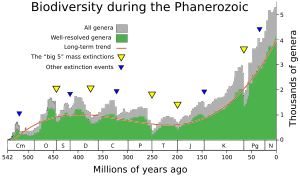
Back حدث الانقراض Arabic Estinción masiva AST Yox olma hadisəsi Azerbaijani Масово измиране Bulgarian বিলুপ্তি ঘটনা Bengali/Bangla Masovno izumiranje BS Extinció massiva Catalan Hromadná vymírání Czech Массăллă пĕтни CV Difodiant mawr bywyd Welsh

An extinction event (also known as a mass extinction or biotic crisis) is a widespread and rapid decrease in the biodiversity on Earth. Such an event is identified by a sharp fall in the diversity and abundance of multicellular organisms. It occurs when the rate of extinction increases with respect to the background extinction rate[1] and the rate of speciation. Estimates of the number of major mass extinctions in the last 540 million years range from as few as five to more than twenty. These differences stem from disagreement as to what constitutes a "major" extinction event, and the data chosen to measure past diversity.
- ^ Sudakow, Ivan; Myers, Corinne; Petrovskii, Sergei; Sumrall, Colin D.; Witts, James (July 2022). "Knowledge gaps and missing links in understanding mass extinctions: Can mathematical modeling help?". Physics of Life Reviews. 41: 22–57. Bibcode:2022PhLRv..41...22S. doi:10.1016/j.plrev.2022.04.001. PMID 35523056. S2CID 248215038.
© MMXXIII Rich X Search. We shall prevail. All rights reserved. Rich X Search
